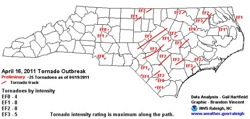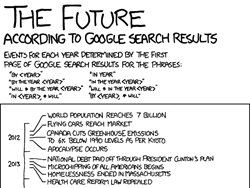 On an average day, I don't spend much time with Twitter. It's the social media water cooler, where there's always something interesting but rarely anything I can't afford to miss. I know, I should make better use of lists to manage the load, but on a typical day, it just doesn't matter much. To me, it's the unusual days that really prove Twitter's value.
On an average day, I don't spend much time with Twitter. It's the social media water cooler, where there's always something interesting but rarely anything I can't afford to miss. I know, I should make better use of lists to manage the load, but on a typical day, it just doesn't matter much. To me, it's the unusual days that really prove Twitter's value.
I recently experienced two events—one good, one bad—that show Twitter at its best. The first was Social2011, Radian6's first user conference (#Social2011). The other was April 16, when North Carolina experienced a record-setting tornado outbreak. One twister passed within a few miles of here, so we were paying close attention.
Conferences and Meetups
Back in 2007, I followed the back-channel conversation at the NewComm Forum using Internet Relay Chat (IRC). It was a fairly geeky tool, and it was real-time only, but it was nice to connect with the event I couldn't attend.
Now, of course, the back channel is always Twitter, and it sometimes threatens to overwhelm the front channel (the person on stage). But Twitter and the hashtag make connecting with the people at the conference and those following remotely easier than ever. If you can keep from being completely distracted by it, the back channel is a great source of connections, discussion, and sharing that enhance the event experience.
Emergencies The back channel has been running at conferences for a few years now, but what's really changing is the role of Twitter in major emergencies. Lately, the news has been the earthquake and its aftermath in Japan, and the continuing unrest roiling the Middle East. The New York Times had a good article on how NPR's Andy Carvin (@acarvin) is experimenting with real-time news coverage on Twitter, just one of the ways in which the platform is proving useful.
The back channel has been running at conferences for a few years now, but what's really changing is the role of Twitter in major emergencies. Lately, the news has been the earthquake and its aftermath in Japan, and the continuing unrest roiling the Middle East. The New York Times had a good article on how NPR's Andy Carvin (@acarvin) is experimenting with real-time news coverage on Twitter, just one of the ways in which the platform is proving useful.
Closer to home—way too much closer, thankyouverymuch—was the tornado that passed within a few miles of my house on April 16. We're fine, but the storms killed 24 people in NC and damaged or destroyed many homes and businesses. Twitter got a workout that day. Here's some of what I saw:
- Sharing official warnings as they were issued. We had a lot of those.
- Sharing damage reports. One user drove around Raleigh and tweeted what he found in several areas. Lots of people shared what they could see.
- Relaying information from broadcast media to people without power in their homes (who were presumably using smart phones for Twitter).
- Pointing to information. Of course, people tweeted and retweeted links to pictures, videos, news coverage, and other information.
- Reassuring and checking on friends. "I'm OK" messages went out as the storm passed, and people started asking about friends known to be in the storm's path.
- Tracking the storms' progress. Tornadoes are over almost as soon as they hit, and you can tell from the tweets where it was over. I ran a trend report on state-specific hashtags (#ncwx, #scwx, #vawx, #mdwx) to see if it showed the storms' advance, but what it showed was a lot of activity in NC—which was hit hardest that day.
- Media reports. Our local TV stations are on their social media games. They have weather-specific accounts and know how to use the hashtags.
- (Not much) official communication. I don't remember much official use of Twitter except for National Weather Service updates. It's interesting to see that NWS is experimenting with crowdsourcing storm reports via Twitter. Note to the #smem folks: remember that social media channels are good for both gathering and disseminating information, especially during emergencies that cover large areas.

